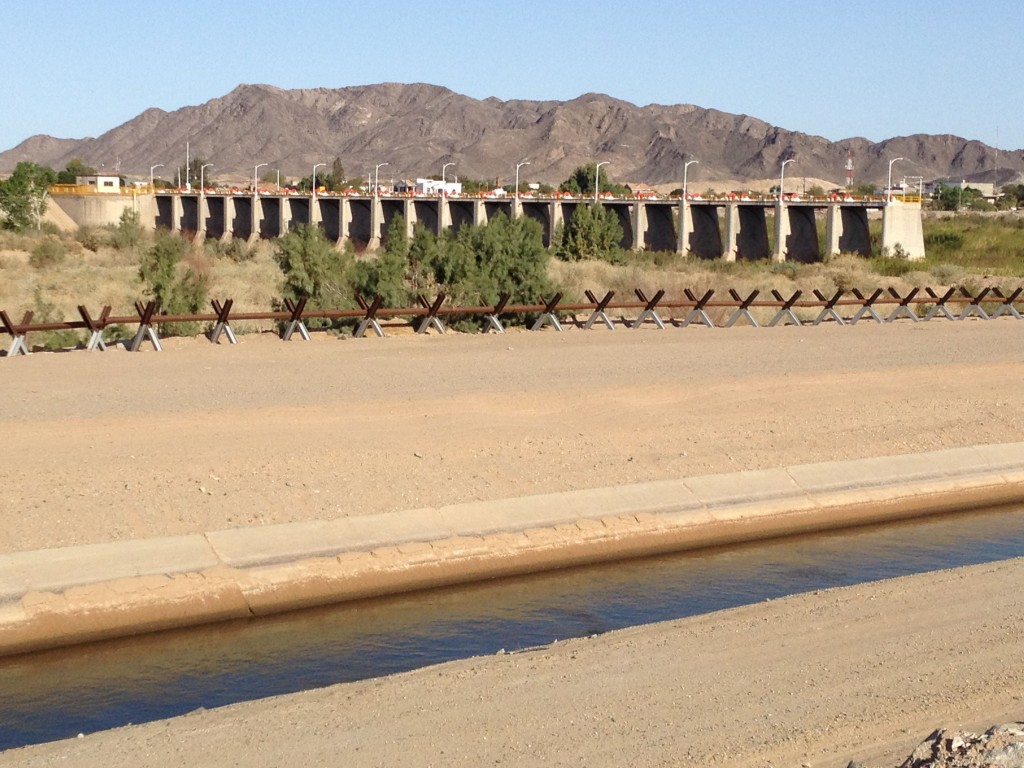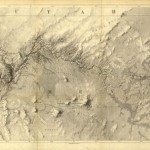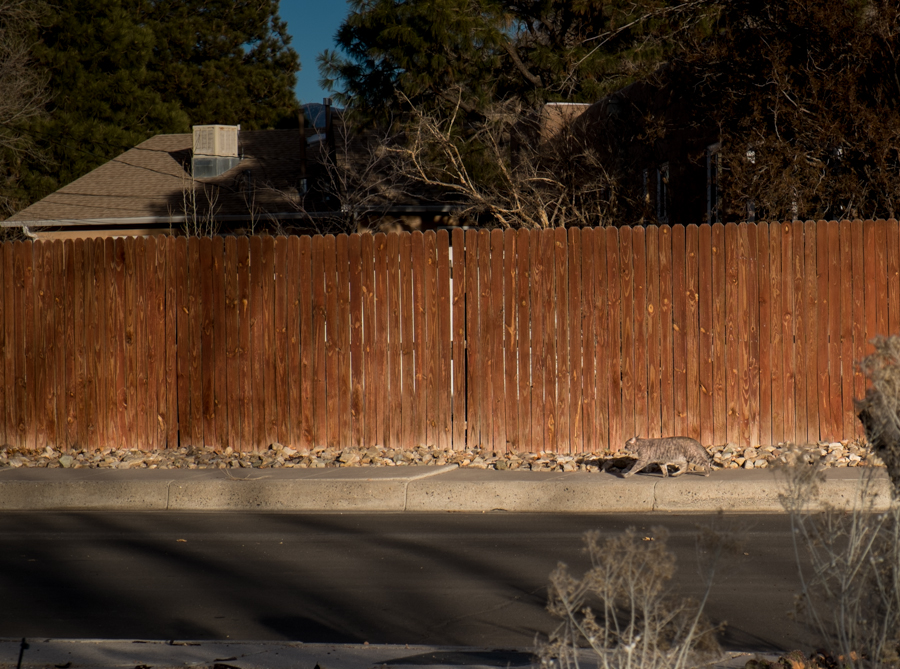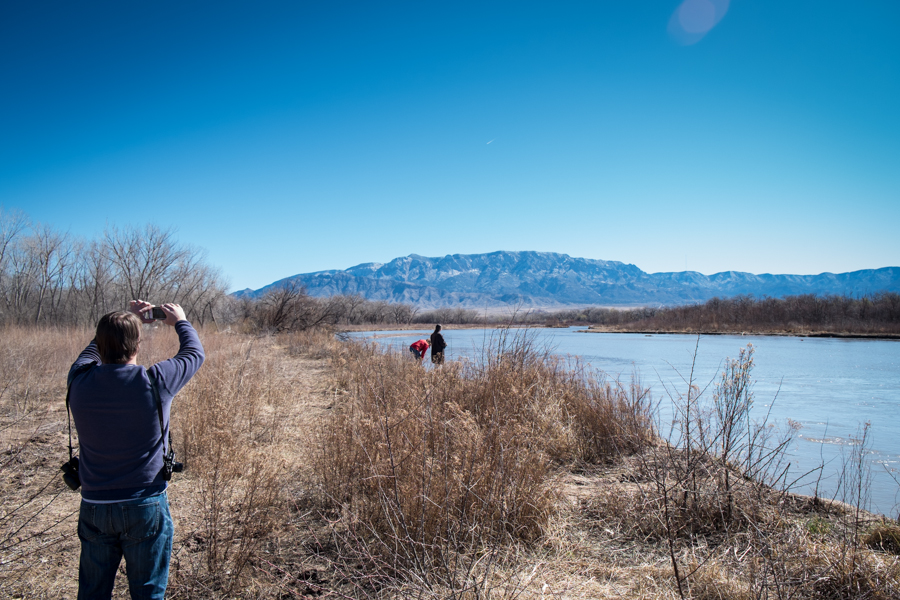
Morelos Dam and the end of the Colorado River, 2010, by John Fleck
When I give talks about western water and the Colorado River they usually end, or sometimes start, at Morelos Dam. Built from 1948-50, it spans the river between Baja California Norte and Arizona, scooping up the last of the great river and diverting it west, to the farmlands of the Mexicali Valley.
Visiting the Lower Colorado River region a few years back, one of my hosts at the Bureau of Reclamation’s Yuma Area Office suggested a drive down the levee on the river’s east bank from Yuma past Morelos Dam to San Luis. It’s probably rhetorical excess to say that drive changed my life, but it sure as hell makes a great storytelling device. A river I’ve spent my whole life on and around, an obsession since I peered down into the depths of the Grand Canyon as a tot and saw a muddy little ribbon between the cliffs, simply stops. In the foreground of the picture above, the Yuma County Water Users Association’s Cooper Lateral delivers Colorado River water to farms on the U.S. side of the border. The road you see is the levee road, with Border Patrol vehicle barriers as a reminder that this is contested ground. Drive south and the levees continue, but they seem comically superfluous, flanking a dry sandy wash, relegated to the service of the ever-present Border Patrol.
If all goes well, at the end of this month I’ll be standing on Morelos Dam watching the Colorado River flow back down that sandy wash. I am very much looking forward to this.
The environmental “pulse flow” beginning this month is an experiment on many levels. At a scientific level, it is an experiment in determining how the parched ecosystem of the once-lush Colorado River Delta responds to the return of water:
The pulse flow experiment is expected to flood low terraces and backwaters, move sediment, elevate the water table, and promote the germination of cottonwood and willow trees…. The information gathered throughout the experiment will be used to inform future binational efforts in the Colorado River delta. (Flessa et al., Flooding the Colorado River Delta, EOS, Dec. 10, 2013)
This is what I think of as the “physical plumbing” level of the experiment. We have turned the Colorado River into a plumbing system, delivering water for human use by 40 million people and 5.5 million acres of land. In the process, that physical plumbing dried up the Colorado River Delta, one of the great estuaries of North America. This experiment will use that physical plumbing to return some water to that natural system. Scientists will be watching and measuring, and I plan on tagging along as much as I can to document what they learn.
But far more important here, I think, is the “institutional plumbing” part of the experiment. In the course of building the dams and canals to deliver all that water to those 40 million people and 5.5 million acres, we also built in parallel a system of institutional plumbing through which we decide how to allocate that water. My notion of “institutional plumbing” is a fuzzy concept, intentionally so, because it’s not entirely clear what fits within its boundaries. Certainly the “Law of the River”, which includes the Colorado River Compact, the Mexican Water Treaty, the various statutes and court decisions that have interpreted and implemented the underlying legal framework. But the institutional plumbing also includes an enormous body of social capital – the people who understand the system and work at the boundaries between physical and institutional plumbing to make the system function.
The thing that makes the “pulse flow” work is a masterwork of an institutional plumbing valve called “Minute 319“, a U.S.-Mexico agreement that acts as an addendum to the two nations’ 1944 treaty governing the management of their shared river. The environmental flow is the shiny part of the deal, but 319 is an incredibly rich, many-layered thing that includes surplus sharing and shortage sharing provisions as well.
Matt Jenkins, in High Country News last December, has done the best takeout on the agreement and the intricate dance between the goals of the environmental interests and the traditional water movers. In short, the big municipal water agencies saw opportunities in Mexico:
[S]ince the early 1990s, the Metropolitan Water District of Southern California had contemplated the possibility of some kind of cross-border water swap. It could provide funding to help Mexican irrigation districts tighten their relatively inefficient water systems, thereby allowing them to grow the same crops using less water. In exchange, Metropolitan would increase its own water use upstream, in the U.S., by a corresponding amount.
Environmentalists, especially the Environmental Defense Fund’s Jennifer Pitt, saw opportunity in that process. If new water was being carved out, maybe some could be carved out and left in the sandy river bed downstream from Morelos Dam. With an increasingly vocal environmental community on the Mexican side of the border and Mexican water users seeing some benefit in a deal that would make themselves more resilient to drought, the space for a grand bargain emerged. Again, Jenkins, who has really done the journalistic heavy lifting on this:
The meetings had blurred traditional lines in water politics, giving conservation organizations unprecedented access to decision-making about the river’s future. And, as Pitt points out, international negotiations proved to be a realm in which many conventional environmentalist tactics – such as using lawsuits to force change – simply don’t work.
“Those tools aren’t there, because you can’t apply them across the border into another country,” she says. “Everything has to be through consensus; there’s no rolling anybody.”
The central thesis of my book is that, for better or worse, we’re stuck with the grandiose physical plumbing we’ve built and the communities that have come to depend on it. Our success or failure in the 21st century will depend on the robustness and resilience of the institutional plumbing to help us adapt to a changing world. It is there, more than in the physical flow of water past Morelos Dam, that the importance of this month’s milestone lies.





